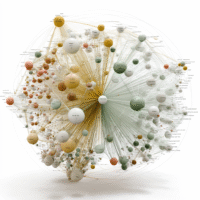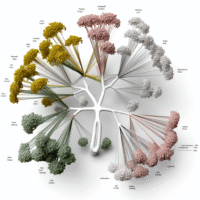AI Tech News
-
Salesforce AI Launches Text2Data: Innovative Framework for Low-Resource Data Generation
Challenges in Generative AI Generative AI faces a significant challenge in balancing autonomy and controllability. While advancements in generative models have improved autonomy, controllability remains a key focus for researchers. Text-based control is particularly important, as natural language provides an intuitive interface between humans and machines. This has led to impressive applications in areas such […] ➡️➡️➡️
-
CODI: A Self-Distillation Framework for Efficient Chain-of-Thought Reasoning in LLMs
Enhancing Reasoning in AI with CODI Chain-of-Thought (CoT) prompting helps large language models (LLMs) perform logical deductions step-by-step in natural language. However, natural language isn’t always the most efficient way for reasoning. Research shows that human mathematical reasoning often does not rely on language, indicating that alternative methods could improve performance. The goal is to […] ➡️➡️➡️
-
Build a Trend Finder Tool with Python: Web Scraping, NLP, and Word Cloud Visualization
Introduction Monitoring and extracting trends from web content has become essential for market research, content creation, and staying competitive. This guide outlines a practical approach to building a trend-finding tool using Python without relying on external APIs or complex setups. Web Scraping We begin by scraping publicly accessible websites to gather textual data. The following […] ➡️➡️➡️
-
Google AI Unveils Differentiable Logic Cellular Automata for Advanced Pattern Generation
Introduction to Differentiable Logic Cellular Automata For decades, researchers have been fascinated by how simple rules can lead to complex behaviors in cellular automata. Traditionally, this process involves defining local rules and observing the resulting patterns. However, we can reverse this approach by creating systems that learn the necessary local rules to generate complex patterns, […] ➡️➡️➡️
-
Getting Started with Kaggle Kernels for Machine Learning
Kaggle Kernels: A Cloud-Based Solution for Data Science Kaggle Kernels, also known as Notebooks, offer a powerful cloud platform for data science and machine learning. This platform allows users to write, run, and visualize code directly in their browser, eliminating the need for local installations. Key Benefits of Kaggle Kernels No Setup Required: Everything is […] ➡️➡️➡️
-
Meet Manus: Revolutionary Chinese AI Agent for Enhanced Productivity
Transforming Business Operations with AI In the digital age, the way we work is changing rapidly, but challenges remain. Traditional AI assistants and manual workflows often struggle with the complexity and volume of modern tasks. Businesses face issues such as repetitive manual processes, inefficient research methods, and a lack of true automation. While conventional tools […] ➡️➡️➡️
-
Microsoft and Ubiquant Unveil Logic-RL: A Rule-Based Reinforcement Learning Framework for Enhanced Reasoning in Language Models
Advancements in Large Language Models (LLMs) Recent developments in large language models (LLMs) such as DeepSeek-R1, Kimi-K1.5, and OpenAI-o1 have demonstrated remarkable reasoning capabilities. However, the lack of transparency regarding training code and datasets, particularly with DeepSeek-R1, raises concerns about replicating these models effectively. To improve our understanding of LLMs, there is a pressing need […] ➡️➡️➡️
-
Diagrammatic Approach for GPU-Aware Deep Learning Optimization by MIT and UCL
Optimizing Deep Learning with Diagrammatic Approaches Deep learning models have transformed fields like computer vision and natural language processing. However, as these models become more complex, they face challenges related to memory bandwidth, which can hinder efficiency. The latest GPUs often struggle with bandwidth limitations, impacting computation speed and increasing energy consumption. Our goal is […] ➡️➡️➡️
-
Evaluating Brain Alignment in Large Language Models for Linguistic Competence Insights
Understanding Language Models and Their Connection to Human Cognition Large Language Models (LLMs) show similarities to how the human brain processes language, but the exact features behind these connections are not fully understood. Insights into how we comprehend language can greatly benefit from advancements in machine learning, which enables LLMs to analyze vast amounts of […] ➡️➡️➡️
-
Inception Launches Mercury: The First Commercial-Scale Diffusion Large Language Model
Introducing Mercury: A Game Changer in Generative AI The launch of Mercury by Inception Labs marks a significant advancement in the field of generative AI and large language models (LLMs). Mercury introduces commercial-scale diffusion large language models (dLLMs), offering improvements in speed, cost efficiency, and intelligence for text and code generation tasks. Mercury: Setting New […] ➡️➡️➡️
-
Finer-CAM: Enhancing AI Visual Explainability for Fine-Grained Image Classification
Introduction to Finer-CAM Researchers at The Ohio State University have developed Finer-CAM, a groundbreaking method that enhances the accuracy and interpretability of image explanations in fine-grained classification tasks. This technique effectively addresses the limitations of existing Class Activation Map (CAM) methods by highlighting subtle yet critical differences between visually similar categories. Current Challenge with Traditional […] ➡️➡️➡️
-
Tufa Labs Launches LADDER: A Self-Improving Framework for Large Language Models
“`html Introduction to LADDER Framework Large Language Models (LLMs) can significantly enhance their performance through reinforcement learning techniques. However, training these models effectively is still a challenge due to the need for vast datasets and human supervision. There is a pressing need for methods that allow LLMs to improve autonomously, without requiring extensive human input. […] ➡️➡️➡️
-
Qilin: A Multimodal Dataset for Enhanced Search and Recommendation Systems
Importance of Search Engines and Recommender Systems Search engines and recommender systems play a crucial role in online content platforms today. Traditional search methods primarily focus on text, leaving a significant gap in effectively handling images and videos, which are vital in User-Generated Content (UGC) communities. Challenges in Current Search and Recommendation Systems Current datasets […] ➡️➡️➡️
-
Parameter-Efficient Fine-Tuning for Optimized LLM Performance: LoRA, QLoRA, and Test-Time Scaling
Introduction to Large Language Models (LLMs) Large Language Models (LLMs) play a crucial role in areas that require understanding context and making decisions. However, their high computational costs limit their scalability and accessibility. Researchers are working on optimizing LLMs to enhance efficiency, particularly in fine-tuning processes, without compromising their reasoning abilities or accuracy. Challenges in […] ➡️➡️➡️
-
CMU’s PAPRIKA: Enhancing Language Models for General Decision-Making Capabilities
Challenges in AI Decision-Making In the fast-changing world of artificial intelligence, a key challenge is enhancing language models’ decision-making skills beyond simple interactions. While traditional large language models (LLMs) are good at generating responses, they often struggle with complex, multi-step problem-solving and adapting to changing environments. This limitation arises from training data that does not […] ➡️➡️➡️
-
Google’s AI System Revolutionizes Disease Management and Medication Reasoning
Challenges of Implementing AI in Clinical Disease Management Large language models (LLMs) face significant challenges in clinical disease management. While they excel in diagnostic reasoning, their effectiveness in ongoing disease management, medication prescriptions, and multi-visit patient care remains untested. Key challenges include: Limited understanding of patient context over multiple visits. Inconsistent adherence to clinical guidelines. […] ➡️➡️➡️
-
AutoAgent: Zero-Code Framework for Creating LLM Agents with Natural Language
Introduction to AI Agents AI agents can analyze large datasets, optimize business processes, and assist in decision-making across various fields. However, creating and customizing large language model (LLM) agents remains challenging for many users, primarily due to the need for programming skills. This requirement limits access to only a small percentage of the population, making […] ➡️➡️➡️
-
Salesforce AI Introduces ViUniT: Revolutionizing Visual Program Reliability with AI-Driven Unit Testing
Understanding Visual Programming in AI Visual programming has gained significant traction in computer vision and AI, particularly in image reasoning. This technology allows computers to generate executable code that interacts with visual content, facilitating accurate responses. It is essential for applications like object detection, image captioning, and visual question answering (VQA). However, ensuring correctness in […] ➡️➡️➡️
-
Erwin: A Tree-Based Hierarchical Transformer for Efficient Large-Scale Physical Systems
Challenges in Deep Learning for Large Physical Systems Deep learning encounters significant challenges when applied to large physical systems with irregular grids. These challenges are amplified by long-range interactions and multi-scale complexities. As the number of nodes increases, the difficulties in managing these complexities grow, leading to high computational costs and inefficiencies. Key issues include: […] ➡️➡️➡️
-
Microsoft AI Launches Belief State Transformer (BST) for Enhanced Goal-Conditioned Sequence Modeling
“`html Introduction to Transformer Models and Their Limitations Transformer models have revolutionized language processing, enabling large-scale text generation. However, they face challenges in tasks requiring extensive planning. Researchers are actively working on modifying architectures and algorithms to enhance goal achievement. Advancements in Sequence Modeling Some methodologies extend beyond traditional left-to-right modeling by incorporating bidirectional contexts. […] ➡️➡️➡️
















